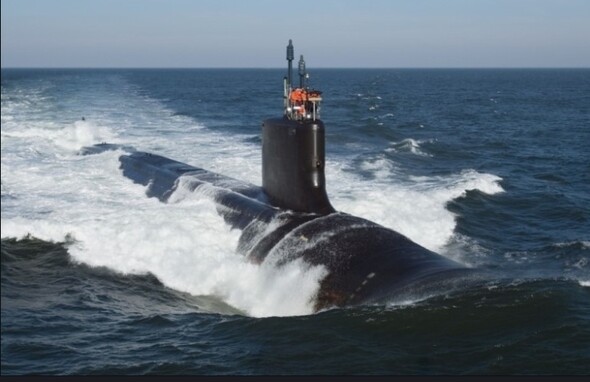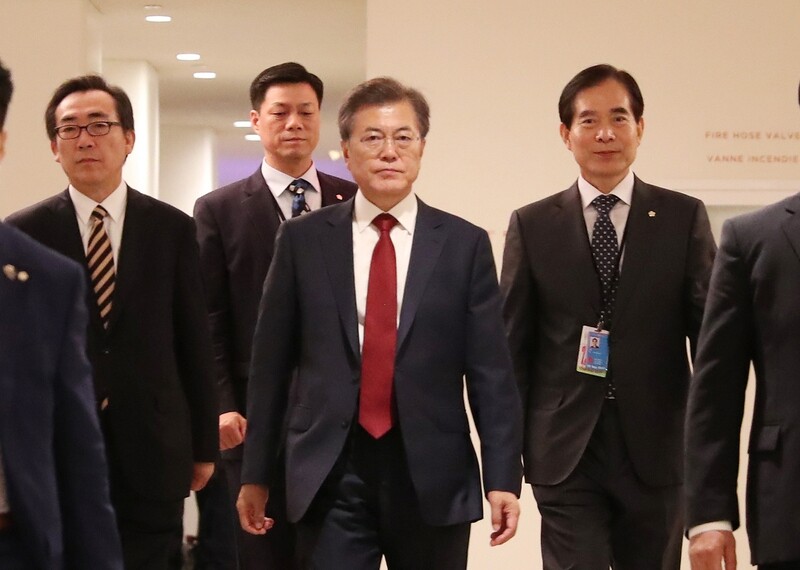hankyoreh
Links to other country sites 다른 나라 사이트 링크
[News Analysis] Debate continues on whether South Korea should acquire SSN nuclear submarines

The question of whether South Korea should acquire SSN nuclear-powered submarines in response to advancements in North Korea’s nuclear and missile programs is drawing major attention. Some argue that the SSN is necessary to boost the military’s defensive capabilities and ensure a deterrent against the North. Rumors also suggest South Korea and the US are in agreement on introducing the submarines.
But the idea is expected to provoke controversy, with the necessary massive budget outlay of 15 trillion won (US$13.2 billion), questions about the submarine’s ability to neutralize the North Korean submarine-launched ballistic missile (SLBM) threat, and the likelihood of its presence being seen as a violation of the Joint Declaration on the Denuclearization of the Korean Peninsula.
■ Continued rumblings for SSN acquisition
In a Sept. 20 position statement, Blue House Senior Secretary to the President for Public Relations Yoon Young-chan stated, “The reports of a South Korea-US agreement on the acquisition of nuclear-powered submarines in certain media differ from the facts,” stressing that “no agreement of any form has been reached as yet between the two sides.” It was a rebuttal of a report the same day in the Joongang Ilbo claiming that the two sides had closely discussed South Korea’s acquisition of nuclear-powered submarines, with apparent plans to announce related details after President Moon Jae-in returns from his current New York visit.
Despite the official denial from the Blue House, political observers claimed that working-level discussions are indeed taking place through various diplomatic and national security channels. In an Aug. 7 telephone conversation with US President Donald Trump, Moon mentioned nuclear-powered submarines once as an area where the South Korean military’s independent capabilities could be boosted; in another conversation on Sept. 17, he expressed gratitude for Trump’s “interest and cooperation toward bolstering [South Korea’s] state-of-the-art weaponry.”
Some believe that the “weaponry” referred to by Moon may have been a reference to the submarines. Another key Blue House official invited further speculation by saying it had been “internally agreed upon that a nuclear-powered submarine would be the most threatening of means to improve the South Korean military’s strategic defense capabilities,” adding that was “no disagreement” on the conclusion.

■ Doubts about neutralizing NK submarine threat
Blue House sources were unanimous about Moon’s firm commitment to acquiring the submarines. During his election campaign, Moon said that “the time has come when we need a nuclear submarine,” adding that he would “discuss amending the South Korea-US nuclear agreement.”
The rationale for acquiring submarines would be as a defense against the North Korean SLBM threat. In Aug. 2016, North Korea successfully launched the SLBM Pukguksong (KN-11) from a Gorae-class submarine – raising fears that South Korea could end up defenseless against the threat of a Pukguksong missile launched by a submarine (believed to be capable of carrying one to two missile launch tubes) secretly entering its rear waters. The nuclear-powered submarine was raised the best option of preventing such an attack.
The best means of doing so, it was argued, would be to position the submarine – which possesses outstanding underwater navigation capabilities – at strategic points in advance to track any North Korean Gorae-class submarines engage in operations, and sink them in the event of signs of an imminent ballistic missile launch.
But many have raised questions about the plan’s effectiveness, noting the difficulty of “blocking one submarine with another.” The claim is that it would be impossible for South Korea to monitor a North Korean submarine unless it were close enough to infiltrate North Korean waters. Also, three submarines would have to be introduced: one each for service, operations, and standby. At a cost of 5 trillion won (US$4.4 billion) each, this would mean an outlay of 15 trillion won (US$13.2 billion). Some are questioning whether the effectiveness would be commensurate with the price tag.
■ Violating the principle of denuclearizing the peninsula
A number of other hurdles remain beyond the technical and financial aspects. To begin with, Article 2 of the Joint Declaration on the Denuclearization of the Korean Peninsula signed by South and North Korea in Dec. 1991 stated that both sides will “only use nuclear energy for peaceful purposes.” This means a ban on military use. Many maintain that as the South’s basis for demanding North Korea’s denuclearization, the declaration cannot simply be abandoned.
Another stumbling block is the South Korea-US nuclear agreement, which was amended in Apr. 2015. Nuclear-powered submarines require enriched uranium as reactor fuel. Article 11 of the agreement only permits uranium enrichment of less than 20%, contingent on written agreement by South Korea and the US. To date, the only countries with nuclear-powered submarines are countries that already have nuclear capabilities: the US, Russia, China, the UK, France, and India.
In light of this situation, the US is unlikely to even allow South Korea to have nuclear-powered submarines, due to the great likelihood of it setting off a domino effect with neighboring countries like Japan. Indeed, the Navy initially pursued plans to build a nuclear-powered submarine during the Roh Moo-hyun administration in 2003, only to abandon them after press reports generated controversy.
By Park Byong-su, senior staff writer and Lee Jung-ae, staff reporter
Please direct questions or comments to [english@hani.co.kr]

Editorial・opinion
![[Column] Has Korea, too, crossed the Rubicon on China? [Column] Has Korea, too, crossed the Rubicon on China?](https://flexible.img.hani.co.kr/flexible/normal/500/300/imgdb/original/2024/0419/9317135153409185.jpg) [Column] Has Korea, too, crossed the Rubicon on China?
[Column] Has Korea, too, crossed the Rubicon on China?![[Correspondent’s column] In Japan’s alliance with US, echoes of its past alliances with UK [Correspondent’s column] In Japan’s alliance with US, echoes of its past alliances with UK](https://flexible.img.hani.co.kr/flexible/normal/500/300/imgdb/original/2024/0419/2317135166563519.jpg) [Correspondent’s column] In Japan’s alliance with US, echoes of its past alliances with UK
[Correspondent’s column] In Japan’s alliance with US, echoes of its past alliances with UK- [Editorial] Does Yoon think the Korean public is wrong?
- [Editorial] As it bolsters its alliance with US, Japan must be accountable for past
- [Guest essay] Amending the Constitution is Yoon’s key to leaving office in public’s good graces
- [Editorial] 10 years on, lessons of Sewol tragedy must never be forgotten
- [Column] A death blow to Korea’s prosecutor politics
- [Correspondent’s column] The US and the end of Japanese pacifism
- [Guest essay] How Korea turned its trainee doctors into monsters
- [Guest essay] As someone who helped forge Seoul-Moscow ties, their status today troubles me
Most viewed articles
- 1[Column] The clock is ticking for Korea’s first lady
- 2Hong Se-hwa, voice for tolerance whose memoir of exile touched a chord, dies at 76
- 3After 2 months of delayed, denied medical care, Koreans worry worst may be yet to come
- 4[Column] Has Korea, too, crossed the Rubicon on China?
- 5[Correspondent’s column] In Japan’s alliance with US, echoes of its past alliances with UK
- 6US overtakes China as Korea’s top export market, prompting trade sanction jitters
- 7Samsung barricades office as unionized workers strike for better conditions
- 8All eyes on Xiaomi after it pulls off EV that Apple couldn’t
- 9More South Koreans, particularly the young, are leaving their religions
- 10John Linton, descendant of US missionaries and naturalized Korean citizen, to lead PPP’s reform effo